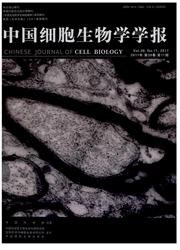

 中文摘要:
中文摘要:
探讨在体外模拟的乳腺癌骨转移微环境中,采用RNAi技术下调骨形态发生蛋白9(bonemorphogeneticprotein9,BMP9)基因对人乳腺癌SK-BR-3细胞增殖、迁移的影响及可能机制。用Transwell小室将空白组SK—BR-3细胞、感染腺病毒AdRFP的对照组SK-BR-3/RFP细胞、感染腺病毒AdsiBMP9的实验组SK—BR-3/siBMP9细胞分别与人骨髓基质HS-5细胞间接共培养后,MTT增殖实验、划痕愈合实验、Transwell迁移实验分别检测下调BMP9对SK-BR-3细胞增殖、迁移的影响:RT-PCR和Westernblot法检测相关因子的变化。结果显示,在共培养体系中,SK.BR-3/siBMP9组的BMP9显著低于对照组(P〈0.05);下调BMP9可有效促进SK—BR-3/siBMP9细胞增殖(P〈0.05),SK—BR-3/siBMP9细胞的划痕愈合率、穿膜细胞数也明显升高(P〈0.05);SK—BR-3/siBMP9组血管内皮细胞生长因子(VEGF)、结缔组织生长因子(CTGF)mRNA和蛋白表达均显著上调(P〈0.05),且Westernblot结果显,-Tz,p—AKT显著_LiN(P〈0.05)。综上,在骨转移微环境中,干扰BMP9表达可促进人乳腺癌SK-BR-3细胞增殖及迁移,其作用机制可能与上调VEGF、CTGF表达有关,且这个过程可能涉及P13K/AKT通路的激活。
 英文摘要:
英文摘要:
To investigate the effects of siRNA-mediated down-regulation of human bone morphogenetic protein 9 (BMP9) on proliferation and migration of human breast cancer SK-BR-3 cells and its possible mechanism in simulated bone microenvironment in vitro, SK-BR-3 cells as blank group, SK-BR-3/RFP cells infected with ade- novirus RFP as control group, and SK-BR-3/siBMP9 cells infected with adenovirus siBMP9 as experimental group were indirectly co-cultured with human bone marrow stromal cells HS-5 with Transwell chamber. Effects of down- regulating BMP9 on SK-BR-3 cell proliferation and migration were investigated by MTT, wound-healing test and transwell migration test; The expression of related factors were screened by RT-PCR and Western blot. The result showed that in the co-culture system, the expression of BMP9 was decreased in SK-BR-3/siBMP9 group (P〈0.05); Down-regulating BMP9 could promote the proliferation of SK-BR-3/siBMP9 cells (P〈0.05), and the wound-heal- ing rate and the number of migratory cells were remarkably increased (P〈0.05); Compared with the control group, the expressions of VEGF and CTGF were significantly up-regulated at mRNA and protein levels in SK-BR-3/ siBMP9 group (P〈0.05), and Western blot showed p-Akt was higher than the control group (P〈0.05). All together, down-regulating BMP9 can promote the proliferation and migration of breast cancer cells SK-BR-3 in microenvi- ronment of bone metastasis, which may be related to up-regulating the expressions of VEGF and CTGF, and PI3K/ Akt pathway may be involved in this process.
 同期刊论文项目
同期刊论文项目
 同项目期刊论文
同项目期刊论文
 BMP9 regulates cross-talk between breast cancer cells and bone marrow-derived mesenchymal stem cells
BMP9 regulates cross-talk between breast cancer cells and bone marrow-derived mesenchymal stem cells BMP9 inhibits the bone metastasis of breast cancer cells by downregulating CCN2 (connective tissue g
BMP9 inhibits the bone metastasis of breast cancer cells by downregulating CCN2 (connective tissue g 期刊信息
期刊信息
